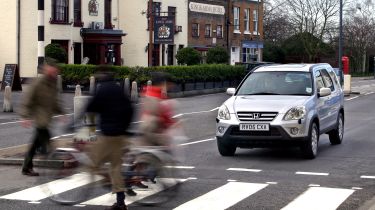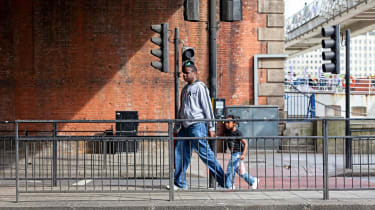Pelican or Puffin crossing? All UK pedestrian crossings explained
We break down the differences between the six different types of pedestrian crossing in the UK

Pedestrian crossings are designed to allow people to safely cross roads on foot, bike or horseback, but there are different variations used for certain roads and situations. All learner drivers must understand the differences between each crossing type before taking their driving test, but it’s just as important for experienced drivers and pedestrians to remain familiar with them. In this guide, we’ll cover the six main crossing types in the UK:
- Pelican crossing – pedestrians only
- Puffin crossing – pedestrians only
- Toucan crossing – pedestrians and cyclists
- Pegasus crossing – pedestrians and horses
- Zebra crossing – pedestrians only
- Staggered crossing – pedestrians only
Whether you’ve just started to learn to drive, or if you just need a quick reminder, read on to find out the differences between the six UK pedestrian crossings.
What is a Pelican crossing?
Pelican crossings are a type of light-controlled pedestrian crossing. All UK pedestrian crossings are named after an animal and Pelican crossings are the most common. Vehicles must obey red, amber and green traffic lights, while a green or red symbol of a person illuminates to tell pedestrians when it’s safe to cross. Some pelican crossings also have a countdown timer for pedestrians to indicate how long they have left to cross the road.
Drivers must be aware of the unique traffic light sequence at a Pelican crossing. At most traffic lights, the lights will change from solid red to solid red and amber when signifying that drivers can prepare to set off. The lights at a Pelican crossing change from solid red to flashing amber, signifying that the driver can progress with caution only if the crossing is clear of pedestrians.
Here’s a quick guide to using a Pelican crossing:
How to use a Pelican crossing
- Pedestrians who want to cross must first press the button on the black and yellow box by the crossing
- A ‘WAIT’ sign will illuminate on the box until the traffic light changes to allow pedestrians to cross.
- While it is not safe to cross, a red man will stay illuminated.
- Once it is safe to cross, a green man will illuminate.
- If the crossing has a countdown timer, this will start once the green man disappears.
- Green, amber and red traffic lights illuminate to regulate the flow of traffic. Green means go, a flashing amber light means you may go with caution if there are no pedestrians crossing, and red means you must stop.
What is a Puffin crossing?
A Puffin crossing is similar to a Pelican crossing. The ‘Puffin’ name is derived from the phrase ‘pedestrian user-friendly intelligent’ crossing and there are a few differences:
- The green and red illuminating people symbols are found on the yellow and black box with the push button to cross – this is intended to help visually impaired users to see the signals more easily.
- Puffin crossings also have additional sensors that detect when pedestrians are waiting to cross and when they have reached the other side.
- There is no flashing amber signal for traffic as the crossing can detect if pedestrians have fully crossed and it is safe for road users to pass. The red light will change to solid red and amber – like most traffic lights – when drivers can prepare to set off.
What is a Toucan crossing?
A ‘Toucan’ crossing is similar to a Puffin crossing and uses sensors to detect pedestrians on the pavement and on the road. The main difference is that both pedestrians and cyclists are allowed to use the crossing from one side of the road to the other in tandem, hence the name Toucan – ‘two-can’.
Toucan crossings are usually wider to accommodate cyclists alongside pedestrians and display a green signal for cyclists alongside the one for pedestrians. These two signals are synchronised.
How is a Zebra crossing different?
Zebra crossings do not have traffic lights. Instead, Zebra crossings are indicated by black and white stripes painted across the road (which is where the name is derived from), along with white and black striped poles at either side of the crossing, topped with yellow lamps, called Belisha beacons.
As per the Highway Code, pedestrians have the right of way at Zebra crossings. This means that drivers will need to be prepared to slow down and stop if they see someone waiting to cross or already walking on the Zebra crossing. Drivers should only set off once all pedestrians have fully crossed the road – just in case they decide to change direction.
As with any crossing, pedestrians should cross with caution, checking beforehand that any drivers have seen them waiting and have slowed down or stopped. Pedestrians should also remember the ‘Stop, Look and Listen’ mantra and be wary of oncoming traffic that could appear out of nowhere. This is especially true on quieter roads, where drivers may be prone to a lapse in concentration.
What is a Pegasus crossing?
A Pegasus crossing – sometimes called an Equestrian crossing – is designed for both pedestrians and horse riders. They are usually wider than Pelican and Puffin crossings, but operate in much the same way. Often, they’ll feature an additional green signal for equestrians, along with a raised push-button that can be more easily operated by a horse rider. Pegasus crossings are usually found in more rural areas, where horse riders tend to be more common.
Drivers should treat a Pegasus crossing in the same way they would a Puffin crossing. Take care not to startle any crossing horse by using the horn or by excessively revving your engine.
What is a staggered crossing?
A staggered crossing is the name given to two or more separate crossings installed to get pedestrians across a larger road. Wide and busy roads with multiple lanes often have staggered crossings; this is to make crossing safer and also to accommodate any difference in the signals given to traffic flowing in different directions.

Staggered crossings should be considered as a series of separate crossings. Each individual crossing will operate in the same way as a Pelican or Puffin crossing, with a central ‘refuge’ section for pedestrians separating them.
That means that crossing one section of the road covered by a green signal for pedestrians doesn't automatically mean it'll be possible to continue without stopping at the next crossing to finish traversing the entire road. This also means that staggered crossings tend to take longer to navigate through.
What is a Panda crossing?
Introduced in 1962, the Panda crossing only lasted until 1969 before being replaced by the Pelican crossing. Like the latter, the Panda crossing operated via a push-button system that was intended to be an upgrade over Zebra crossings, but its sequence of lights proved confusing for drivers and pedestrians and the system was plagued with mechanical failures, leading to the short-lived use of Panda crossings.
Spend a lot of your time on two wheels as well as four? Check out our list of the Top 10 best cars for bikes and cyclists...
Most Popular
Tips & advice

Car dashboard warning lights: what does each symbol mean?

Electric car charging stations: public networks, charger types, apps and maps






